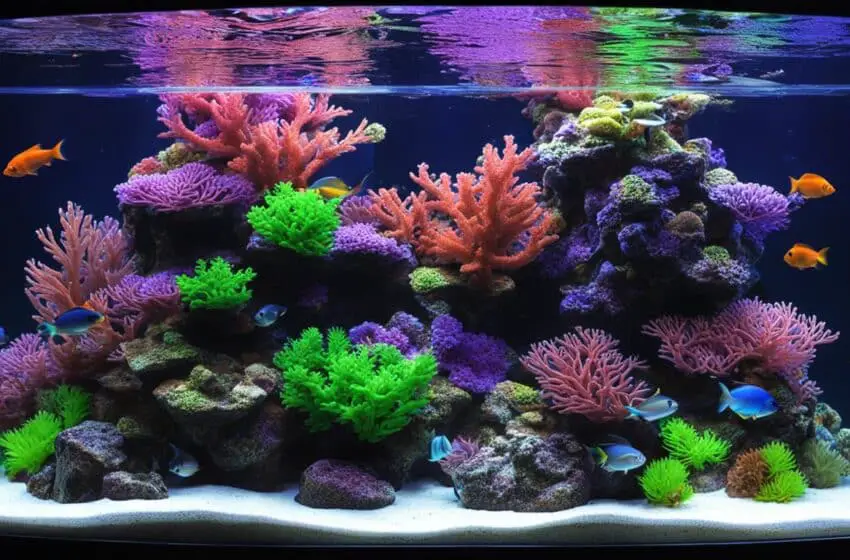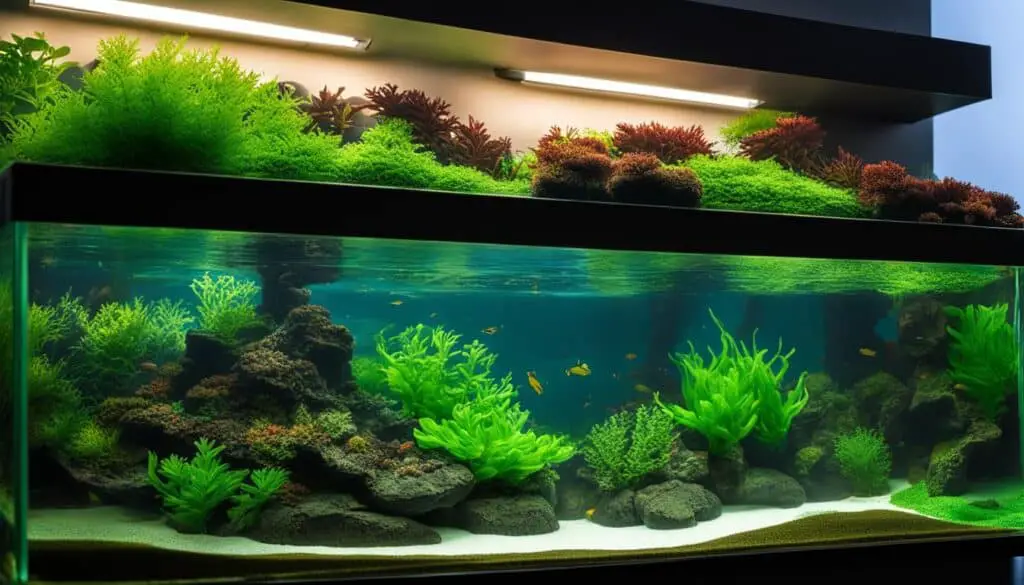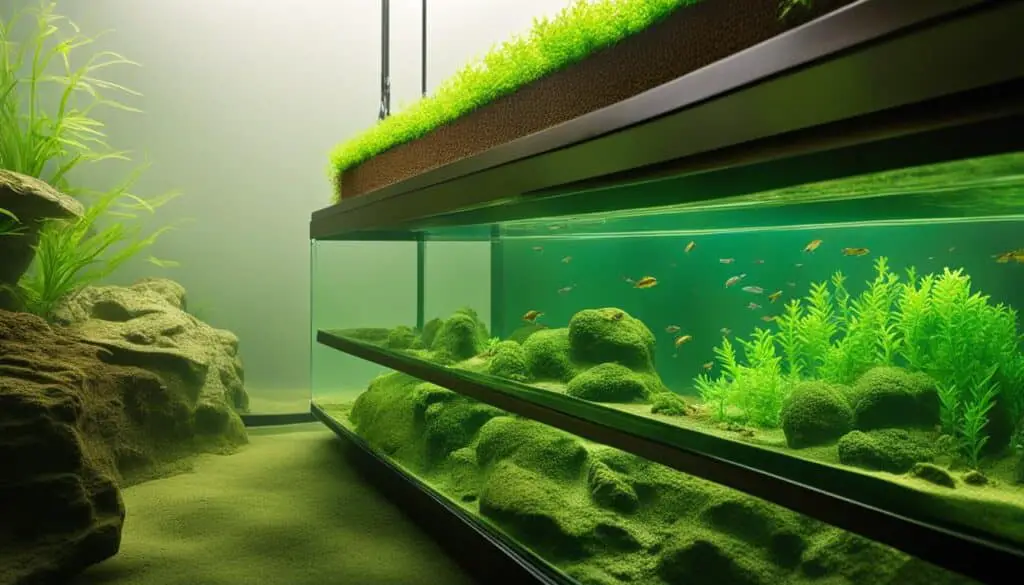Overcoming Algae Issues with Proper Aquarium Lighting

Algae growth is a common issue faced by saltwater aquarium owners. The presence of algae not only detracts from the aesthetics of the tank but can also hinder the health and growth of other organisms in the aquarium. However, with the right approach to aquarium lighting, algae problems can be effectively controlled and reduced.
The key to preventing algae growth lies in maintaining a balanced environment. Algae tend to thrive in conditions with excess light and limited nutrients or CO2. Factors such as poor water circulation, insufficient surface agitation, and an imbalance of light, CO2, and nutrients can contribute to the growth of algae. In addition, a new aquarium setup with low quantities of beneficial bacteria can also encourage algae blooms.
To combat algae growth, regular aquarium maintenance is essential. This includes performing regular water changes and vacuuming the substrate to prevent the buildup of organic waste. Adding a high population of algae-eating animals, such as Amano shrimp and snails, can also help control algae growth. Increasing the plant mass in the aquarium and using fast-growing plants can further reduce the risk of algae outbreaks.
By properly addressing lighting and nutrient levels, saltwater aquarium owners can successfully overcome algae issues and create a healthy and visually appealing aquatic environment.
Key Takeaways:
- Algae growth can be prevented by maintaining a balanced environment with sufficient light, nutrients, and CO2.
- Regular aquarium maintenance, including water changes and substrate vacuuming, is crucial to control algae growth.
- Increasing the population of algae-eating animals and introducing fast-growing plants can help in algae control.
- Understanding different types of algae and their characteristics is important for effective algae prevention and control.
- Properly balancing lighting and nutrient levels is essential for maintaining a healthy and vibrant aquarium ecosystem.
Understanding Algae in Aquariums
Algae, resembling plant-like organisms, require water, sunlight, and nutrients to thrive in aquariums. They manifest in various forms, such as greenish or yellow-brown particles, white or gray filamentous masses, and black or gray clumps. While a modest presence of algae indicates a balanced aquarium ecosystem, excessive algae growth signifies an imbalance.
Algae contribute to water cleanliness and serve as a food source for specific fish and invertebrates. However, an overgrowth of algae can hinder plant growth by depriving them of essential nutrients and oxygen, leading to their deterioration. Recognizing different types of algae, including brown algae, blue-green algae, red or black-beard algae, green algae, and green-water algae, aids in effective algae control.
The Role of Algae in an Aquarium Ecosystem
Algae play a vital role in maintaining an aquarium ecosystem by cleaning the water and serving as a food source for certain organisms.
Algae are part of the natural biological filtration system in an aquarium, acting as the first line of defense against impurities. They absorb excess nutrients and help control water chemistry. Additionally, some fish, such as Siamese algae eaters and certain snails, actively consume algae. These algae-eating organisms assist in algae control and maintaining a healthy aquarium environment.
The Impact of Excessive Algae Growth
Excessive algae growth can disrupt the balance of an aquarium ecosystem and hinder plant health.
When algae growth becomes excessive, it can outcompete plants for vital resources, resulting in weakened or stunted plant growth. Algae can also create unsightly green water, obstructing visibility within the tank. Therefore, implementing effective methods to control algae growth is essential for maintaining a balanced and aesthetically pleasing aquarium.
Types of Algae Found in Aquariums
Understanding the different types of algae enables targeted and tailored algae control methods.
Several types of algae commonly occur in aquariums. By familiarizing yourself with their characteristics, you can identify and address specific algae issues effectively. The most common types of algae include:
- Brown algae: Often found in newly established aquariums, it forms brown or rusty patches on surfaces.
- Blue-green algae: Also known as cyanobacteria, it appears as slimy, greenish-blue mats that can rapidly cover plants and substrates.
- Red or black-beard algae: This type of algae forms dense, black, or reddish clumps on driftwood, rocks, and plant leaves.
- Green algae: Green algae can take various forms, including green spots on glass and decorations, as well as filamentous strands.
- Green-water algae: Often creating a cloudy appearance in the water, green-water algae are tiny, free-floating cells that give the water a green hue.
Each type of algae requires specific algae control measures to effectively reduce or eradicate their presence in the aquarium.
Tips for Algae Prevention and Control
To effectively prevent and control algae overgrowth in your aquarium, maintaining a proper balance between lighting and nutrients is crucial. Several key strategies can help you reduce algae overgrowth and maintain a healthy tank.
1. Reduce Light Intensity and Duration
Excessive light exposure can promote algae growth. Consider reducing the intensity and duration of lighting to inhibit algae proliferation. Avoid prolonged exposure to direct sunlight, as this can exacerbate the issue.
2. Control Feed Amount
Overfeeding can lead to the accumulation of excess nutrients in the water, providing an ideal environment for algae to thrive. Ensure you only provide your fish with the appropriate amount of food and promptly remove any uneaten food from the tank.
3. Increase Water Changes
Frequently changing the water in your aquarium helps remove accumulated nutrients that can contribute to algae growth. Aim to change approximately 20% of the water every one to two weeks, depending on your specific setup.
4. Monitor Nutrient Levels
Regularly testing the water for nutrient levels can provide valuable insights into the conditions that may be fueling algae growth. Keep an eye on phosphates and nitrates, as high levels of these nutrients can contribute to excessive algae development.
5. Improve Overall Aquarium Cleaning
Thoroughly cleaning your aquarium and equipment on a regular basis can help prevent organic waste buildup and reduce the chances of algae overgrowth. Clean the aquarium glass, filter media, and any decorations to eliminate any potential algae nurseries.
6. Introduce Algae-Eating Fish
Algae-eating fish, such as Siamese algae eaters, can be valuable allies in controlling algae growth. These fish have a voracious appetite for algae and can help keep it in check. Introduce them to your tank to maintain a healthy balance.

Additionally, manual removal of algae can be effective, especially in tackling specific areas of overgrowth. Consider using algae scrapers or toothbrushes to remove algae from the glass, decorations, and other surfaces within the tank.
Finally, balancing the lighting and nutrient levels in your aquarium is critical for long-term algae control. Introducing fast-growing stem plants can help overshadow the algae, reducing its access to light and nutrients. This competitive advantage can help keep algae growth under control.
| Prevention and Control Strategies | Effectiveness |
|---|---|
| Reducing light intensity and duration | ✔️ |
| Controlling feed amount | ✔️ |
| Increasing water changes | ✔️ |
| Monitoring nutrient levels | ✔️ |
| Improving overall aquarium cleaning | ✔️ |
| Introducing algae-eating fish | ✔️ |
| Manual removal of algae | ✔️ |
| Introducing fast-growing stem plants | ✔️ |
Dealing with Specific Types of Algae
Each type of algae requires specific strategies for control. Understanding the characteristics and behavior of different algae types is crucial in effectively managing their growth in your aquarium.
Brown Diatom Algae
Brown diatom algae is a common occurrence in new aquarium setups. It typically forms a thin, brownish film on various surfaces. The best way to control brown diatom algae is to allow your tank to mature naturally. As the aquarium ecosystem stabilizes, beneficial bacteria and microorganisms will develop, helping to limit the growth of brown diatom algae. Introducing algae-eating organisms, such as nerite snails or Siamese algae eaters, can also be beneficial in keeping brown diatom algae in check.
Black Beard Algae
Black beard algae, also known as brush algae, can be a challenging type of algae to deal with. It often appears as dark tufts or clumps on plants, rocks, or decorations. Manual removal of affected areas is one method of control, but it is important to be thorough to prevent regrowth. Chemical treatments, such as hydrogen peroxide dip or the use of commercially available algae control products, can also help eliminate black beard algae. Introducing algae-eating fish, like Siamese algae eaters or certain species of plecos, can provide long-term control by consuming the algae.
Hair Algae
Hair algae, as the name suggests, has a hair-like appearance and can quickly cover plants and other surfaces in the aquarium. To control hair algae, it is important to address the underlying causes. Adjusting lighting intensity and duration, ensuring proper nutrient levels, and providing good water circulation can help prevent hair algae outbreaks. Introducing algae eaters, such as amano shrimp or Siamese algae eaters, can also help control hair algae by consuming it as a food source.
Green Spot Algae
Green spot algae appears as small green spots on the glass, substrate, or other surfaces in the aquarium. To remove green spot algae, manual scraping or the use of specialized algae scrapers is effective. Alternatively, you can use acrylic-safe cleaning solutions specifically designed for algae removal. Regular maintenance and cleaning will help prevent the growth of green spot algae.
Blue-Green Algae (Cyanobacteria)
Blue-green algae, or cyanobacteria, can form slimy, blue-green or greenish mats in your aquarium. Improving aquarium upkeep and water circulation is crucial in controlling blue-green algae. Increasing water changes and ensuring a well-maintained nitrogen cycle can help reduce nutrient levels and the growth of blue-green algae. In severe cases, the use of antibiotic treatments may be necessary to control its spread. However, it is important to address the root causes of nutrient imbalance to prevent reoccurrence.
Green Water
Green water is caused by an overgrowth of free-floating algae, resulting in a cloudy or greenish appearance of the water. To treat green water, one method is to blackout the tank for a few days by covering it with a light-blocking material. This method limits the light available to the algae, causing them to die off. Another effective approach is using UV sterilizers, which kill the algae as the water is pumped through the unit. Both methods should be combined with a thorough cleaning of the tank and maintenance practices to prevent future green water outbreaks.

Balancing Lighting and Nutrients for Algae Control
When it comes to effectively controlling algae in your aquarium, finding the right balance between lighting and nutrients is essential. Maintaining a harmonious relationship between these two factors is the key to creating a healthy and thriving aquarium ecosystem. By ensuring that your plants receive the proper amount of light and nutrients, you can establish a balance that discourages excessive algae growth.
One important factor to consider is lighting intensity and duration. Gradually adjusting the lighting settings in your aquarium can help prevent algae overgrowth. By gradually increasing or decreasing the intensity and duration of light, you can find the sweet spot that promotes plant growth while minimizing algae growth.
Another strategy is to use all-in-one fertilizers. These products provide a comprehensive mix of essential nutrients that plants need to thrive. By using such fertilizers, you can ensure that your plants receive the necessary nutrients to outcompete algae for resources.
“Finding the right balance between lighting and nutrients is crucial for maintaining a balanced aquarium ecosystem and preventing excessive algae growth.”
Regularly monitoring nutrient levels in your aquarium is also crucial. Testing the water parameters can help you identify any imbalances and make necessary adjustments. By keeping nutrient levels in check, you can provide the ideal conditions for your plants to grow and flourish, while limiting the availability of excess nutrients that can encourage algae growth.
It’s important to note that achieving a completely algae-free aquarium may be challenging. Instead of aiming for complete eradication of algae, focus on successfully growing your plants. A modest presence of algae is considered normal and can even contribute to a balanced ecosystem. By creating an environment where plants are thriving, you can mitigate the risk of excessive algae growth.
Here’s a summarized step-by-step guide to balancing lighting and nutrients for effective algae control:
- Gradually adjust lighting intensity and duration.
- Use all-in-one fertilizers to provide comprehensive nutrients.
- Regularly monitor and test water parameters to maintain nutrient levels.
- Focus on successfully growing plants rather than eliminating all algae.
Expert Tip:
“To maintain the balance between lighting and nutrients, it’s important to take into account the specific needs of your aquarium plants. Different plant species may have varying light and nutrient requirements, so research and tailor your care accordingly.”
By following these guidelines and consistently monitoring and adjusting lighting and nutrient levels, you can create a healthy and balanced aquarium ecosystem that minimizes the risk of excessive algae growth. Remember, achieving the perfect balance may require some trial and error, but with dedication and patience, you can achieve a beautiful and thriving aquarium.
Conclusion
Successful algae control in a saltwater aquarium requires a deep understanding of the causes of algae growth and the implementation of effective prevention and control strategies. Maintaining a balanced aquarium ecosystem is key to combating algae issues and ensuring the health and vibrancy of your underwater world.
Proper lighting, nutrient levels, water circulation, and regular maintenance play crucial roles in creating a balanced aquarium environment. By carefully balancing lighting and nutrients, introducing algae-eating organisms, and manually removing algae as needed, you can keep algae growth in check and preserve the beauty of your aquarium.
While achieving a completely algae-free aquarium may be difficult, with dedicated care and attention, you can create a well-balanced and thriving aquatic ecosystem. Regular monitoring of water parameters, adjustments to lighting and nutrient levels, and commitment to ongoing aquarium maintenance will contribute to a more balanced environment and effective algae control.
By following these tips and maintaining a balanced aquarium ecosystem, you can enjoy the beauty and tranquility of your saltwater aquarium without the frustration of excessive algae growth. With proper care, your aquarium will flourish, allowing both the plants and the fish to thrive in a harmonious and visually stunning underwater world.
FAQ
What causes algae growth in aquariums?
Algae thrives in an imbalanced environment, with excess light and few nutrients or CO2. Low quantities of beneficial bacteria in a new setup, poor water circulation, insufficient surface agitation, and an imbalance of light, CO2, and nutrients can all contribute to algae growth.
How can I prevent algae growth in my aquarium?
Regular aquarium maintenance, including water changes and substrate vacuuming, is essential to prevent organic waste buildup. Increasing the population of algae-eating animals, such as Amano shrimp and snails, can also help control algae growth. Increasing the plant mass in the aquarium and using fast-growing plants can reduce the risk of algae outbreaks.
What are the different types of algae in aquariums?
Algae can appear in various forms, including greenish or yellow-brown particles, white or gray filamentous masses, and black or grey clumps. Understanding the different types of algae, such as brown algae, blue-green algae, red or black-beard algae, green algae, and green-water algae, can help in effective algae control.
How can I control algae growth in my aquarium?
To prevent and control algae overgrowth, it is important to maintain a balance between lighting and nutrients in the aquarium. Reducing light intensity and duration, controlling feed amount, increasing water changes, testing water for nutrient levels, and improving overall aquarium cleaning can help prevent excessive algae growth. Adding algae-eating fish, such as Siamese algae eaters, and using algae scrapers or toothbrushes for manual removal of algae can be effective for control.
How do I deal with specific types of algae?
Each type of algae requires specific strategies for control. Brown diatom algae can be controlled by allowing the tank to mature and introducing algae-eating organisms. Black beard algae may require the use of chemical treatments, manual removal, or introducing algae-eating fish. Hair algae can be controlled by adjusting lighting, increasing nutrient levels, and introducing algae eaters. Green spot algae can be removed using algae scrapers or acrylic-safe solutions. Blue-green algae or cyanobacteria can be partially controlled by improving aquarium upkeep and water circulation and using antibiotics. Green water can be treated by blacking out the tank or using UV sterilizers to kill the algae.
What is the importance of balancing lighting and nutrients for algae control?
Balancing lighting and nutrients is crucial for effective algae control. Providing the right amount of light and nutrients for plant growth is key to maintaining a balanced aquarium ecosystem. Gradually adjusting lighting intensity and duration, using all-in-one fertilizers, and monitoring nutrient levels can help achieve this balance. Regular testing of water parameters and adjustments to lighting and nutrient levels can help achieve and maintain the balance necessary for algae control.



